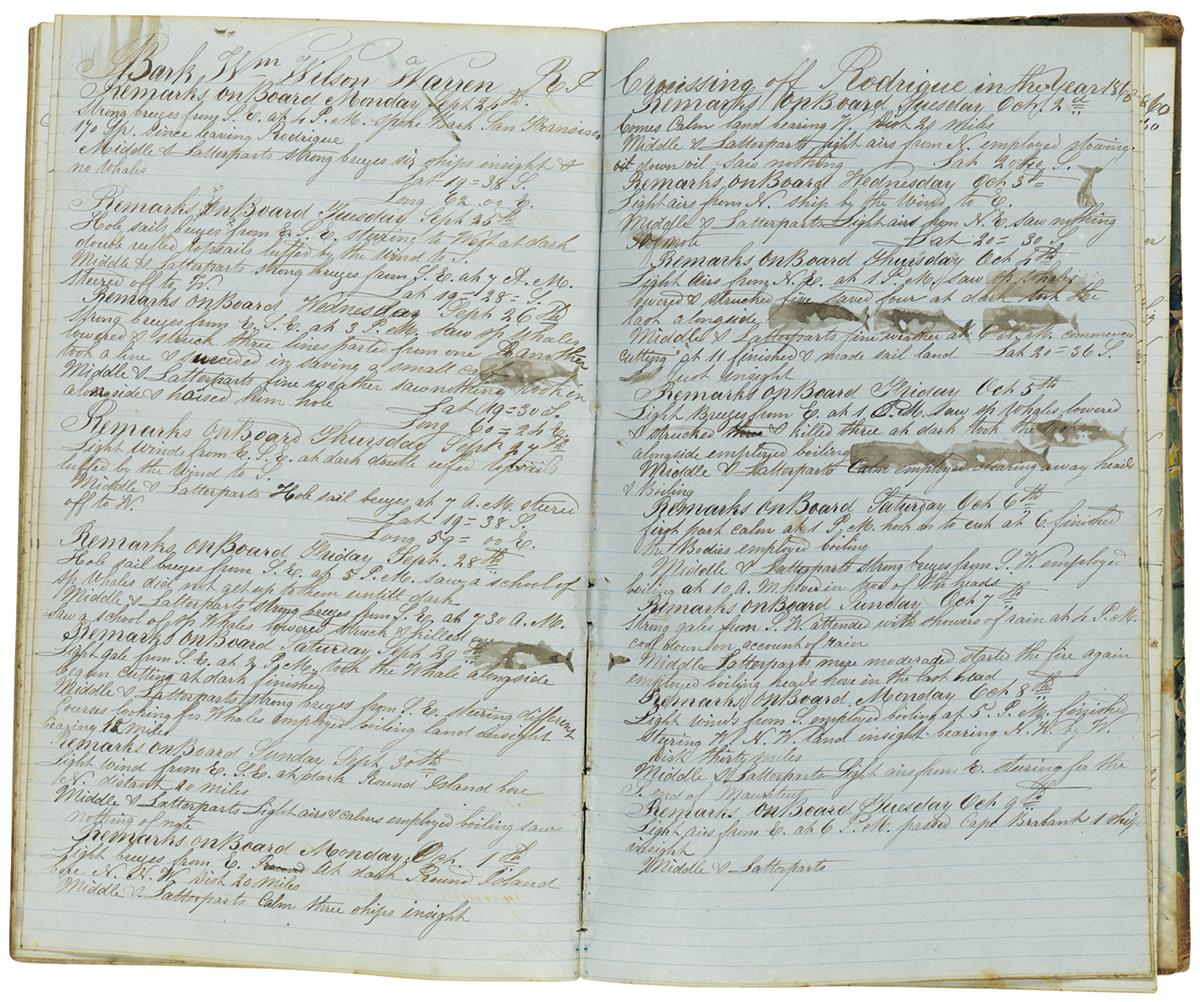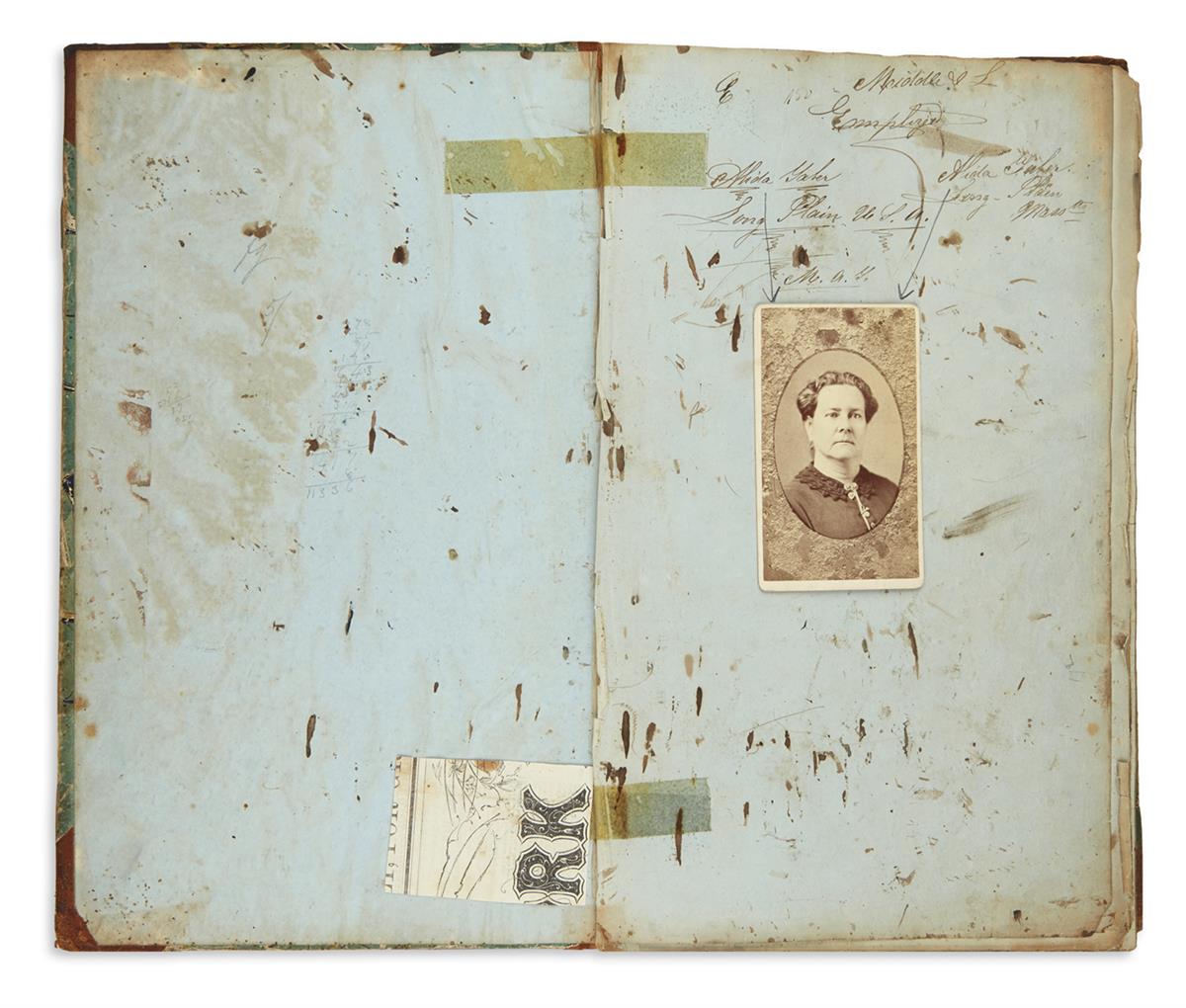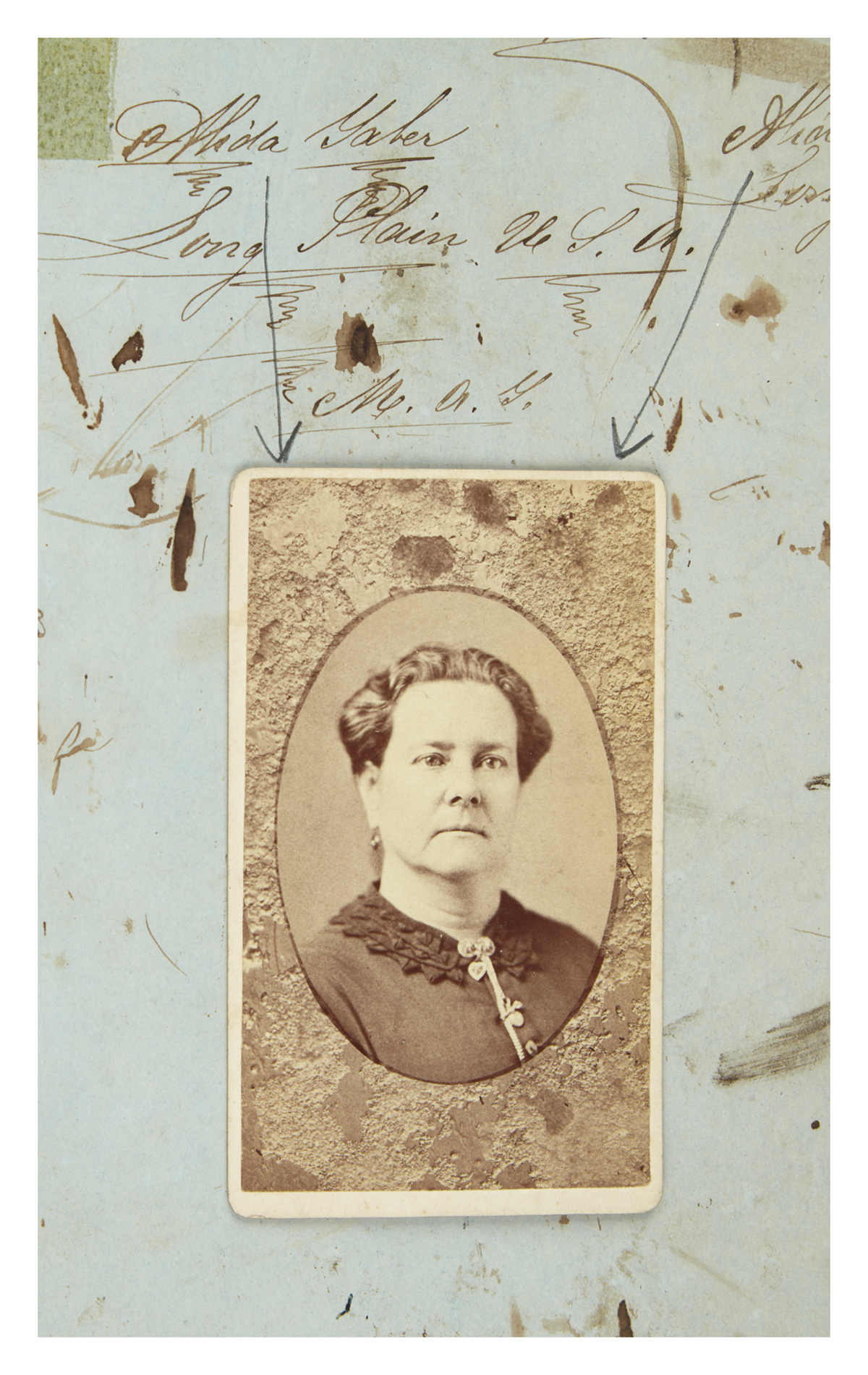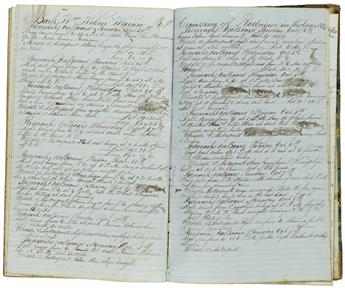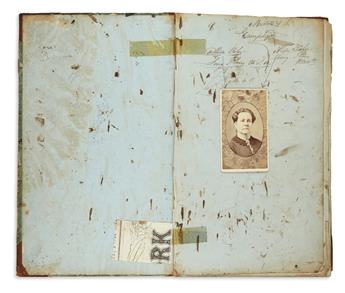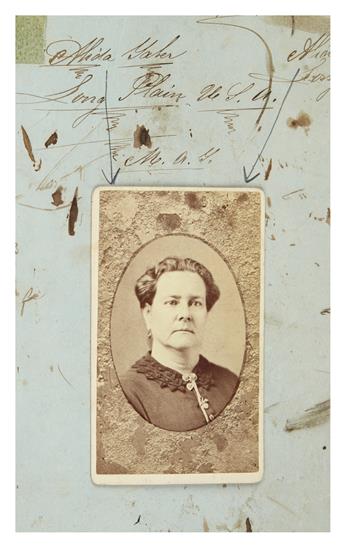Sale 2505 - Lot 229
Price Realized: $ 12,000
Price Realized: $ 15,000
?Final Price Realized includes Buyer’s Premium added to Hammer Price
Estimate: $ 4,000 - $ 6,000
(WHALING.) Taber, Alida. Diary kept by the wife of a whaling captain, including two whaling expeditions. Carte-de-visite photograph of the author on first leaf, 25 inked whale stamps. 102 manuscript pages. Folio, contemporary 1/2 calf, worn and coming disbound; leaves loose, minor dampstaining and wear to gutter margin on a few leaves, a few cello tape repairs, some text leaves apparently used as a scrapbook but later restored, some blank leaves apparently excised. Vp, 1853-61
Additional Details
Marie R. A. "Alida" Lehongre (circa 1832-1908) was born on the British island colony of Mauritius to French parents. She married whaling master George Taber of Acushnet, MA. The first page of this logbook is adorned with her photograph, as well as several ownership inscriptions. She kept this log in three sections. The first segment records a voyage from Hawaii to Connecticut in 1853; the second segment is kept in the style of a ship's log, though it records Alida's daily activities on shore; and the third segment picks up mid-voyage cruising the Indian Ocean in search of whales in 1860.
The first section is titled "Journal of a Voyage on Board the Brig Magdalene from Honolulu to the United States of America with a Cargo of Oil and Bone" and signed by Alida Taber. Alida was a young wife at this time, about 21 years of age; it uis quite possible that she married George in Mauritius on this trip; only the return trip after the successful whaling voyage is recorded. In traditional fashion, the log records the daily wind and weather, latitude and longitude, and anything of note that occurred. The number of days out at sea is also indicated in the margin of each entry. Alida frequently reports that the crew is employed repairing sails or fitting rigging. On at least one day she remarks on seeing some porpoises, and occasionally sighting other ships, but on the whole it was a fairly quiet journey. The ship stopped for supplies on the island of "Whitalacke" (probably Aitutaki in the Cook Islands) on 10 February. On 7 May, 117 days out to sea, the entry reads: "took on deck 22 bundles of bone, found some in a damaged state." The next few days are spent involved with activities that concern drying and bundling whale bone. On 13 May they arrive at Pernambuco on the coast of Brazil, where she notes that they are "waiting for the Portugues holy days to pass." It ends with a return to port in New London, CT on 4 July.
The second section is a diary of Alida's life in Acushnet while George is at sea from January to August 1859. The entries are reminiscent of a ship's log, with each day headed "Remarks" and the date. On 3 January, the entry reads: "It is fifteen months today since my husband left his home. I wish before another year ends that he will be near me. I have been sewing on his shirts. I made a shirt & partly another one." She records weather, visits with friends, ailments, sewing and housework, and letters written and received. "January 8th. Today I received a letter from my dear . . . & was the happy wife on earth to hear that he was well. Mrs. Harris has not had any letters from her husband yet but we are all in hope she will next week." On 17 May she mentions sending an ambrotype to her mother, and on 28 July she writes of traveling into New Bedford to have her daguerreotype taken. Toward the end of the section, she mentions exchanging money for English coins and going on a trip, ending the log aboard a ship in Boston harbor.
The final segment picks up on 27 May 1860 aboard the bark William Wilson, cruising off of Rodrigues Island near Mauritius in the Indian Ocean. Alida did not sign this section, but the handwriting is identical to the earlier sections. This portion of the log book contains active whaling, with inked stamps of whales denoting occurrences of sightings and lowering the boats. As with any sea voyage, many days go by with very little of interest, interspersed with spurts of furious activity around the sighting and pursuit of whales. The entry for June 6 reads: "At 2 P.M. saw a school of sp[erm] whales, at 4 P.M. lowered and killed three, at 8 o'clock took the last one along side. . . . At 6 A.M. hooked on to cut." The next day is spent cutting in, and the two days following are spent in boiling and rendering. On July 10, three more whales are taken: "At 1 P.M. saw a school of sp whales, lowered strucked & killed three of 5, took the last one alongside & secured things for the night." This again is followed by three days of cutting and trying out. From June onward, the ship seems to have been successful every two or three weeks, taking four whales at once in October ("struck five, saved four"). Alida notes that they boiled the bodies and then "hove in two of the heads" for processing. By late October, the ship is headed back for the States, ending mid-entry on January 5, apparently before entering port.
The first section is titled "Journal of a Voyage on Board the Brig Magdalene from Honolulu to the United States of America with a Cargo of Oil and Bone" and signed by Alida Taber. Alida was a young wife at this time, about 21 years of age; it uis quite possible that she married George in Mauritius on this trip; only the return trip after the successful whaling voyage is recorded. In traditional fashion, the log records the daily wind and weather, latitude and longitude, and anything of note that occurred. The number of days out at sea is also indicated in the margin of each entry. Alida frequently reports that the crew is employed repairing sails or fitting rigging. On at least one day she remarks on seeing some porpoises, and occasionally sighting other ships, but on the whole it was a fairly quiet journey. The ship stopped for supplies on the island of "Whitalacke" (probably Aitutaki in the Cook Islands) on 10 February. On 7 May, 117 days out to sea, the entry reads: "took on deck 22 bundles of bone, found some in a damaged state." The next few days are spent involved with activities that concern drying and bundling whale bone. On 13 May they arrive at Pernambuco on the coast of Brazil, where she notes that they are "waiting for the Portugues holy days to pass." It ends with a return to port in New London, CT on 4 July.
The second section is a diary of Alida's life in Acushnet while George is at sea from January to August 1859. The entries are reminiscent of a ship's log, with each day headed "Remarks" and the date. On 3 January, the entry reads: "It is fifteen months today since my husband left his home. I wish before another year ends that he will be near me. I have been sewing on his shirts. I made a shirt & partly another one." She records weather, visits with friends, ailments, sewing and housework, and letters written and received. "January 8th. Today I received a letter from my dear . . . & was the happy wife on earth to hear that he was well. Mrs. Harris has not had any letters from her husband yet but we are all in hope she will next week." On 17 May she mentions sending an ambrotype to her mother, and on 28 July she writes of traveling into New Bedford to have her daguerreotype taken. Toward the end of the section, she mentions exchanging money for English coins and going on a trip, ending the log aboard a ship in Boston harbor.
The final segment picks up on 27 May 1860 aboard the bark William Wilson, cruising off of Rodrigues Island near Mauritius in the Indian Ocean. Alida did not sign this section, but the handwriting is identical to the earlier sections. This portion of the log book contains active whaling, with inked stamps of whales denoting occurrences of sightings and lowering the boats. As with any sea voyage, many days go by with very little of interest, interspersed with spurts of furious activity around the sighting and pursuit of whales. The entry for June 6 reads: "At 2 P.M. saw a school of sp[erm] whales, at 4 P.M. lowered and killed three, at 8 o'clock took the last one along side. . . . At 6 A.M. hooked on to cut." The next day is spent cutting in, and the two days following are spent in boiling and rendering. On July 10, three more whales are taken: "At 1 P.M. saw a school of sp whales, lowered strucked & killed three of 5, took the last one alongside & secured things for the night." This again is followed by three days of cutting and trying out. From June onward, the ship seems to have been successful every two or three weeks, taking four whales at once in October ("struck five, saved four"). Alida notes that they boiled the bodies and then "hove in two of the heads" for processing. By late October, the ship is headed back for the States, ending mid-entry on January 5, apparently before entering port.
Exhibition Hours
Exhibition Hours
Aliquam vulputate ornare congue. Vestibulum maximus, libero in placerat faucibus, risus nisl molestie massa, ut maximus metus lectus vel lorem.



